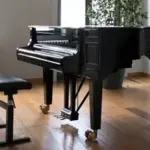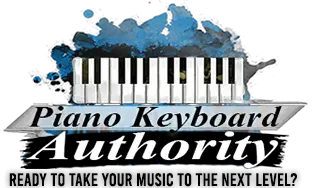 At a Glance
At a Glance
If you are looking for a Yamaha P105 review because you’ve been eyeing on this piano keyboard for a while then you’ve come to the right place. 88-key piano keyboards are popular among musicians who want a lot of octave during any performance and do have enough space at home for a bigger keyboard. So, what exactly makes the Yamaha P105 good and what are its minor cons? Read on to find out!
The Yamaha P105’s Features and Benefits
Here are some of the basic specifications of the Yamaha P105:
CFIII Sampled Piano
What does this mean? Basically, that means it’s sa mpled from the Yamaha CFIII concert grand piano. All digital keyboard pianos are sampled from real pianos, and the fact that this keyboard’s samples come from a highly-acclaimed Yamaha concert grand is a good choice for sound quality.
mpled from the Yamaha CFIII concert grand piano. All digital keyboard pianos are sampled from real pianos, and the fact that this keyboard’s samples come from a highly-acclaimed Yamaha concert grand is a good choice for sound quality.
Great Polyphony
This piano keyboard’s polyphony is up to 128 notes. Polyphony refers to how much notes you can play simultaneously without one getting cut off. This is very important if you are playing different melodies, chords and dual voices on the keyboard (more on that feature later).
88 Weighted Keys
They’re not just 88 keys – they’re also GHS weighted keys! It’s what most people call the “soft touch” piano keyboard, and this one reenacts a real acoustic piano since the heavier touch is on the left while the highs have the lighter touch. You get a touch of full realism with this digital piano at hand!
AUX Line Out
This means that you can connect the Yamaha P105 to your computer or DAW and then record your performance. There’s a USB cable included so connecting it will be a breeze. Added to that, the speakers also make use of the “true line output” so they will keep playing your piano tunes while you connect it to your computer.
The Good Stuff
What exactly makes the Yamaha P105 a great digital piano keyboard? Here are some of its pros or advantages:
Dual Voice Mode
There’s nothing more convenient than having a dual voice mode, in which you can play strings with one hand and piano on the other. Not many keyboards out there (especially cheaper ones) have this kind of mode since they only focus on a single instrument per selection.
This can be helpful if you are playing a song live and need to add some thickness to your sound. It can be used on most church services as well as on some acoustic night live shows. You can even use it for recording in the studio!
Drum Patterns
Basically, this really helps if you don’t have a drummer or drum machine at home or in your concert venue. In fact, many worships and church services use digital pianos that have drum patterns as a backup so that their songs will become livelier (and more people will attend the mass). Drum patterns are also a non-boring way to put up a metronome beside you as you play.
It’s a Long Keyboard!
If you’re a full-fledged artist, or you just want to be able to play Beethoven’s “Moonlight Sonata mvt. 1” then you’re definitely going to need a higher octave than just 61 keys. Having 88 keys in total puts you to an advantage when creating songs without having to transfer to a higher octave using switches. This would also be useful if you want to play complex melodies from lower, thundering bass to the subtle highs.
Speakers Stand Out
The included speakers aren’t just for show – they actually work well even without having to bring a bulky speaker with you on a gig! This can save you a lot of baggage and on electricity consumption. You also don’t have to connect the keyboard to an external speaker if the venue is small enough. You can also use the speakers to practice anywhere!
The Not-so-good Stuff (but not Deal Breakers)
Of course, like other products, there are small and minor cons with the Yamaha P105 (depending on your preference/situation), such as the following:
Insufficient Voices
The voices refer to the different types of tones or instruments that you can select in the keyboard. While this keyboard focuses more on the pure sounding CFIII sampling, sadly, it doesn’t have a lot of voices as compared to other digital keyboards out there. Therefore, this keyboard may be best used as mainly an acoustic piano or keyboard.
Not for Small Spaces
Of course, this keyboard may not be your ideal one if you have limited space at home. While it is true that 88 keys are a great thing for most intermediate and advanced players or pianists, it might be too much for those who are still starting out and may end up not really making use of all the keys yet. Do measure your home space first if you want to fit in a keyboard in mind.
No MIDI In/Out
This is a con for most music producers or composers, but not very much for beginners or casual players. MIDI lets you record notes on a DAW or digital audio workstation so you can edit them later if you make mistakes. While it does not have a MIDI port, you can just use the AUX port in order to record your performance, although it won’t be as easily editable as with a MIDI port.
As a Whole
We think that the Yamaha P105 would be the best choice for those who simply want a great acoustic piano that’s digital, with 88 full weighted keys and a realistic sound. If you’re used to playing a real grand piano then you will feel nostalgic with the sampled sounds of this digital counterpart from Yamaha.
While it lacks instruments and a MIDI port, it’s still a great pick if you just want to be able to play music on an acoustic night event or on local gigs and bars. The sound quality and the weighted action are both great with this piano keyboard.
Do you think the Yamaha P105 interests you enough? Check out its updated price on Amazon right now!
